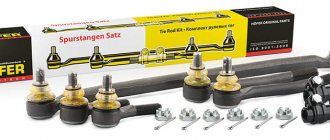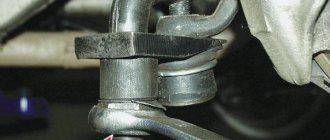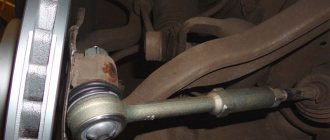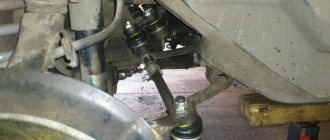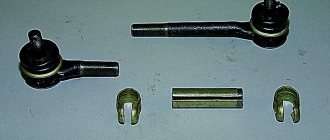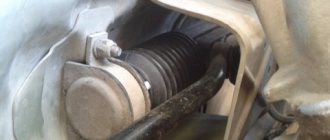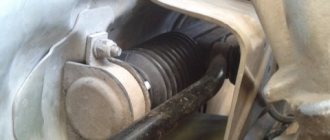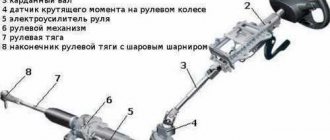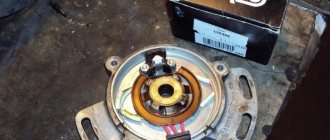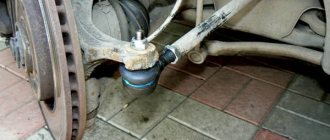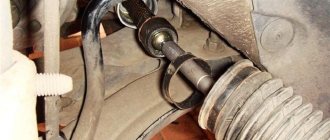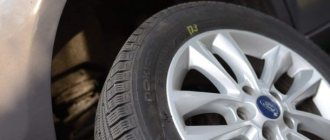A pressing question for many car enthusiasts is how to remove the steering rack. And this is not surprising, because it is one of the most important mechanisms of the machine. How the vehicle will be driven mainly depends on it. Therefore, you need to monitor and maintain it in good condition.
A number of factors indicate the failure of this mechanism, but the most popular are: characteristic noise, backlash appears, and oil stains appear under the machine. If you notice this, then you need to take the necessary measures as soon as possible. One of the repair methods is to replace the rack. However, before replacing the steering rack, you need to remove it correctly.
Steering rack design
The main integral elements of the slats are:
- crankcase;
- gear shaft;
- support sleeve;
- spool mechanism.
In order to repair a steering rack, you need not only special equipment, but also sufficient experience, since the repair process is quite complex. Directly repairing the rack involves the following steps:
- disassembling the rack, washing and troubleshooting parts;
- parts that cannot be restored are replaced;
- the rack toothed shaft is cleaned and checked;
- Oil seals, anthers, rings and other parts are replaced.
Disassembling the steering rack. Preparatory stage
Before you begin the repair, you need to clearly understand what type of model we are talking about. The following structures are subject to diagnostics and repair:
- mechanical steering racks;
- power steering racks;
- electric power steering racks.
Each of the above mechanisms is installed on a car. Depending on this, an algorithm for carrying out work is built. The initial stages are typical for all types of slats.
What you need to have with you: a set of automotive tools, a portable lighting device, rags, spare parts, repair kits.
How to determine if the rack is faulty
The control unit of a German car is extremely reliable, but sometimes its elements break. The following signs indicate malfunctions and the need for repair of the Audi A4 steering rack:
- the reaction of the wheels to the driver's steering commands is slow;
- the steering wheel is loose;
- On rough roads, knocks in the steering wheel are clearly felt.
Having discovered signs indicating incorrect steering operation, you need to go to a service center as quickly as possible. Only repairs can correct the situation.
Steering rack overhaul - in what cases and repair technology is carried out
Hello, dear car enthusiasts! Sooner or later the time comes when it is necessary to repair the power steering rack (power steering). In order to figure out how to sort out the steering rack using a live example, and not just with your fingers, we will look at the procedure for performing this work using the example of a Nexia car.
The principle of the steering rack design of almost any car is no different. Naturally, there are nuances and features of the design and type of placement of the steering rack on the car. It is to clarify these features of the steering of your car that there is a manual from the manufacturer.
In what cases is it necessary to disassemble the steering rack?
The reasons for the need to repair the steering rack are simple: the appearance of a knock when driving over uneven roads and when the steering wheel is rhythmically rocked to the sides while driving, when there is play in the steering wheel.
Before you begin repairing the steering rack, you should definitely check the steering ends and the condition of the steering rods. If they are normal, you can try to tighten the steering rack.
If the desired results are not obtained, you should check for play in the area where the rods are attached. When tightening the rods, the knocking noise may become even stronger, and the steering wheel will turn more and more difficult. And, if all efforts to adjust the steering gear were in vain, then we can move on to the question of how to rebuild the steering rack?
Preparation for repair: tools and materials for steering rack repair
Many novice car enthusiasts who try to do car repairs with their own hands have a question: where to start, and how to disassemble the steering rack.
And you need to start by studying the maintenance manual for your car, or technical literature, which is now offered in abundance in technical bookstores, but most often on the Internet.
You should also purchase a repair kit in advance to restore the steering mechanism. Well, of course, you need to prepare an appropriate set of tools that may be required during the repair process.
It is worth including a set of wrenches: open-end and socket, as well as a time-tested lubricant such as Litol. Although today the market offers steering rack lubricants, the basis for all lubricants is, in principle, the same.
You just need to remember that the steering rack lubricant must correspond to the temperature conditions of the region in which your car is operated.
Repair technology: disassembling and reassembling the steering rack
If a car enthusiast is performing the operation of disassembling the steering rack for the first time, it is advisable for him to have a skilled assistant who, at the right moment, can provide the necessary tool or support a suspended unit. So, let's start disassembling the steering rack:
- Before starting work, you need to set the steering wheel to the middle position and mark the current position of the shaft with a marker or chalk. This needs to be done because during assembly it will be easier to determine which shaft tooth to put on the rack;
- Drain the oil by unscrewing the tubes that go to the rack from the front. After this, attach the tubes in place. Now you need to unscrew the propeller shaft bolt and remove the rack from the cross member;
- The steering gear parts must be thoroughly washed, for example, in engine cleaner. It is more convenient to do further disassembly of the rack on the table.
- To replace the upper repair kit, you need to pull the bearing off the shaft.
- To replace the lower set, you need to remove the wire stopper by rotating the bushing on the rack shaft.
- In the center of the rack body there is a cuff and a washer; they must be replaced. When pressing in new parts, you must not damage the corner edge of the seal.
- During installation and assembly, you need to check that the shaft enters the rack correctly, then put the driveshaft on the splines, while simultaneously pulling the rack to the cross member.
- Now you should check that the steering wheel is in the middle position, then the rack can be completely assembled and carefully fastened.
Typically, the most common diagnosis of damage is significant wear on the worm shaft. It should be replaced with a new one. Assembly should be performed in the reverse order of disassembly.
Based on the results of the steering rack repair, you can see that reassembling the steering rack is not a very complicated procedure. In conclusion, I would like to remind fans of fast driving: shaft wear could be less if the driver overcomes uneven areas more carefully, monitors the tire inflation and carries out timely vehicle inspection and preventive maintenance.
We diagnose the condition of the steering rack ourselves
The function of the steering rack is to transmit rotation of the steering wheel to the wheels. The steering rack is the main tool for driving a car. If a malfunction occurs, the car’s obedience decreases under shock loads and driving on uneven roads. With severe operation of the equipment, the mileage of 210-240 is the maximum wear of the steering rack, which now requires replacement and repair.
How to identify a malfunction
To determine whether the steering rack is faulty, we look at the following aspects:
- bumps and turns are accompanied by a characteristic knocking sound in the area of the steering mechanism;
- deterioration in handling when driving at high speed, when the car bounces a little from side to side;
- increased steering play;
- heavy or jerky steering wheel rotation;
- to return the steering wheel to its original position, tighten it yourself;
- characteristic noise of the power steering pump when we turn the steering wheel;
- We note the drop in oil in the power steering reservoir;
- Oil is leaking near the rack.
If the car is equipped with an electric booster, check whether the electric motor has failed. The circuit is probably closed or the contacts in the connectors have oxidized. The fuses also blow, resulting in the steering wheel.
What are tie rod ends used for?
This unit sets the desired angle of rotation of the car's wheels and ensures the mobility of the entire steering system.
The tie rod ends take on most of the shock load, ensuring that the tie rods and racks retain their strength; the ends significantly increase the service life of these mechanisms. Shock loads occur when moving quickly over uneven surfaces (potholes, gravel, crossings). All these factors lead to wear of the steering tips, which causes damage to the steering system.
Characteristic signs of a faulty steering rack
The most characteristic sign of a faulty steering rack is a knocking sound . A characteristic, and not entirely pleasant, knocking noise comes from under the front axle of the car. At first, this knocking is almost unnoticeable, but over time the intensity increases significantly.
After some time, these knocks begin to be heard in the steering wheel. After this, driving on uneven roads and making sharp turns is very dangerous. At such moments, the twitching of the steering wheel is very noticeable.
What to do to avoid being deceived at a car service center? How to avoid it, click on any of the messengers below to find out 5 simple ways to avoid being scammed
The important point is that characteristic signs of a faulty steering rack are observed only in small holes. But the car goes through deep holes without any obvious knocking. In this case, there is a high probability that the unit has become unusable, and you will need to replace the steering rack yourself.
Another signal about a faulty steering rack is the tight operation of the unit itself . This usually manifests itself in the fact that it becomes difficult to turn the steering wheel only in one direction. Also, under the car, after parking, there may be an oil leak, which is observed on the unit itself and on the asphalt, and a hum in the power steering. These symptoms should not be neglected, because... indicates that the car will soon be unacceptable to use. It can lead to bad consequences, including an accident. This malfunction is typical for hydraulic mechanisms. In most cases, failure of the steering rack is associated with a malfunction of the seals and rod .
Wheel play is another characteristic feature of a faulty steering rack. This is easy to determine. It is enough to grab the wheel with your hands and pull it in different directions. The play should be pronounced and well felt by the hands. In this case, the steering wheel can rotate freely left and right at low speed. The sharpness and response disappear when the driver turns the steering wheel. The best way out of this situation is to replace the steering wheel with your own hands.
Frequent failure of the steering rack is associated with damage to the joint .
The main reason that this unit failed is due to the fact that the driver likes to drive fast on bad roads.
Hitting an obstacle at speed, sudden braking, worn out boots - this can cause a problem with the steering rack. Through cracks in the anthers, dirt and sand get inside, where they mix with oil. Thereby speeding up the slats and supports.
You need to know and remember that you should not leave a car with the wheels turned to one side for a long time in cold weather. Hydraulics can break down quickly.
It is important to remember that operating a car with a faulty steering rack is unsafe . Leads to loss of vehicle control. If a breakdown is detected, it is necessary to immediately begin repairing it.
We recommend: How to repair a driveshaft on a European truck?
Selection of tie rod ends
40–50 thousand km is the mark at which it is usually worth replacing steering tips, since they are consumables. Sometimes the quality of the tips leaves much to be desired, which is why they have to be replaced earlier than scheduled maintenance, especially in domestic cars.
So, on VAZ cars, steering tips are replaced every 15–20 thousand km, but the frequency of replacement also depends on the manufacturer of spare parts. There are repairable tips, but their repair requires a lot of experience and qualifications, and is carried out exclusively by professionals.
It is extremely important to replace tie rod ends in pairs! Replacing only one side is not permissible, since these elements fail almost simultaneously.
A set of keys and a special puller are what is needed when replacing the steering tip. The puller allows you to separate the tip from the hub. If it is not there, then car owners often simply loosen the nut that holds the tip and hub together, and then knock out the tip with strong and sharp blows of a hammer. But there is a risk of damage to suspension and body parts.
When is replacement required?
The main signs that an Audi steering rack requires repair or replacement are:
- An unnatural knocking noise that intensifies while driving on uneven road surfaces;
- The need to exert force while turning the steering wheel;
- Spontaneous rotation of the steering wheel;
- The steering wheel does not return well to the center position after the car exits a turn;
- Excessive sensitivity of the car to the driver’s actions;
- The angle of rotation of the wheels does not correspond to the angle of rotation of the steering wheel;
- Significant drop in fluid level in the power steering reservoir.
A timely response to these problems and contacting qualified specialists to eliminate them will prevent even more complex and costly breakdowns of the unit.
Basically, the Audi steering rack “suffers” due to an aggressive driving style, external aggressive influences, the use of low-quality fuels and lubricants, and a number of other reasons. Due to the intense load on the contact points of the gears and gear base, these elements are most often subject to mechanical wear, abrasion and destruction. Problems can be resolved in the following ways - adjusting the optimal distance between the rack and gears, replacing damaged components, or replacing the entire assembly.
DIY replacement
To replace the unit, you need the following:
- a bottle of white spirit;
- three clamps measuring 200x4;
- soft cloth;
- Movil aerosol or equivalent;
- any lubricant for processing bearings, Mobile Griz, Feola, or any other good quality will do;
- WD-40 to unscrew rusty parts.
In addition, you will need spare parts, namely:
- tubes;
- - tips;
- silent blocks;
- rack repair kit;
- anther.
The tools you need to stock up on are:
- hammer;
- keys set to “22”, with an internal octagon;
- chisel;
- cardan;
- puller for dismantling tips.
Now let's get to work
- First of all, you need to treat all fasteners and parts with engine oil (WD-40) and leave for an hour and a half. Afterwards, repeat the treatment with engine oil and it’s better to start working in a day, otherwise it’s simply impossible to unscrew the stuck parts, you’ll either break the threads and damage important components, or you’ll break something for yourself. To avoid such trouble, it is better to do everything in order, without haste.
- When the oil saturates the fasteners, you can begin dismantling. We fix the car, put supports under the wheels. Don't forget about the handbrake and lock the steering wheel.
- Disconnect the power and remove the front wheels.
- Unscrew the nuts from the ends;
- Armed with a puller, we knock out the fingers from the rack arms. To prevent the puller from flying away, hold it with a key.
- Remove the clamp fasteners.
- Now we are carrying out dismantling work in the cabin itself: the bolt on the steering shaft is removed, it is located near the floor.
- After all these operations, we pull the rail towards ourselves. It is easier to dismantle if you pull it out with a rotating motion.
- After dismantling the rack, the control mechanism is pulled out through the resulting hole.
- If the rack cannot be repaired, it is replaced with a new one. Installation is carried out in the reverse order to dismantling.
Removing the steering rack
To successfully remove the steering rack, follow the step-by-step instructions.
- Raise the car on stands from the front and remove the wheels.
- We press out the steering tips, which are located in the steering knuckle axles, using a special puller.
- We remove the rack heat shield.
- If a hydraulic booster is installed, unscrew the hoses in which the oil is supplied and processed. Place a container in advance to carefully drain the liquid.
- We unscrew the bolts that secure the steering rack from the subframe or engine shield, which is determined by the make of the car.
- Slightly loosen the pinch bolt that holds the universal joint and the steering shaft together.
- To release the spline connector, pull the rack in the direction of the steering shaft. The rail does not always move easily, so we use a hammer and knock it out of place with a small blow.
- We pull out the rack through the wheel arch (left or right - determined by the layout of the space under the hood).
Each car has its own engine compartment. If the subframe is in the way, unscrew the rear bolts with the engine mount. Next, move the subframe lower and pull out the steering rack. We do not completely remove the subframe - this is a rather labor-intensive process.
Removing the rack with a simple mechanism
If you are the owner of a car with a fairly simple configuration that includes a rack and pinion mechanism, then to remove the steering racks you will need:
- determine the location and loosen the fastening of the rack and pinion mechanisms;
- completely disconnect the steering racks from the tips;
- unscrew the connecting bolts of the rails from the car body;
- find the output of the cardan clutch with the racks;
- release the steering racks from the cardan mechanism;
- pull out the parts from the side where there are no fasteners or obstacles.
It should be noted that most standard instructions contain only the main points, without familiarization with the nuances and details of this procedure. For this reason, drivers without appropriate experience are strongly discouraged from proceeding with independent inspection and removal of racks, relying on their own strength and the information they have read. In the absence of special tools and equipment, as well as practical skills, you can simultaneously damage other parts, thereby further aggravating the situation and increasing the total repair costs.
Repair or replacement?
Replacing a faulty steering rack is easier than repairing, but is more expensive. If we consider a new original rack for a Ford Focus II 2009, the cost is 800 euros. A copy will cost 350 euros.
A kit to repair the steering rack for this car is estimated at 40-50 euros. All that remains is to buy clamps and anthers, which will cost approximately 10 euros. To remove and repair the steering rack, we prepare a set of wrenches. To assemble and disassemble the slats, you cannot do without a special tool, which must be purchased separately.
Removing the steering rack with your own hands, using a garage and available tools, is profitable, but not reliable. Therefore, it is better to remove the rack in a specialized car service center, in conditions where there is a suitable kit for removing, repairing and restoring the functionality of problematic steering rack elements. The savings are obvious, but nevertheless, we evaluate our strengths in order to justify the upcoming expenditure of effort, emotions and time.
Is it possible to inexpensively repair the steering rack?
Technicians in Moscow can perform high-quality repairs at an affordable price. The service station has spare parts for all Audi models.
How to check the tie rod end
Self-checking steering rods involves inspecting the control system parts on a lift or in a pit. You can first find out about problems with the steering tips by the knocking noise that occurs when you turn the steering wheel to the sides on a flat section of the road.
Inspection of steering tips and checking traction includes:
- Visual inspection of parts to ensure there are no deformations.
- Checking the protective covers of the ball joint of the tip (there are no cracks through which dust, water, or dirt can enter).
- Definition of tip play - movement along the axis of the fingers should not exceed 1.5 mm.
If you do not know how to check the steering ends on your car, you do not have the ability to properly diagnose, then it is better to contact a specialized car service center.
How to replace the steering rack with your own hands?
If there is serious damage to the surface of the steering rack or gear mechanism, then the steering rack needs to be replaced.
Before you begin work, you should read the instructions for replacing the rack for your car. In addition, a day before starting work, we recommend spraying WD-40 on all bolts and nuts to make it easier to unscrew them later.
- With the car on a level surface, apply the parking brake. We recommend placing something under the rear wheels, for example, bricks.
- The steering wheel is set to neutral. And the wheel nuts are loosened one by one. The car is raised on a jack and the front wheels are removed.
- The next step is to remove the absorber, thereby opening access to the steering rack.
- Then we move on to unscrewing the tips. You can then knock out the tips with a hammer. However, it is worth doing this if you are going to change the tips along with the steering. Otherwise, it is better to use a puller.
- The fastening nuts on the clamp holding the steering rack are unscrewed. And the clamp is removed.
- The steering rack is free, all that remains is to pull it out. It is most convenient to do this from the passenger side.
- Then you need to install a new one in its place, performing the steps in reverse order.
We recommend: Electric additional pump for the heater of VAZ and other cars: selection and installation
It is worth remembering that after replacing the steering rack with your own hands, you need to adjust the wheel alignment yourself or at a service station.
Preparing to remove the steering rack
You must first secure the vehicle and set the parking brake. For greater reliability, it is better to place chocks under the rear wheels. After the machine is securely fixed, you need to:
- set the steering wheel to neutral position;
- loosen the wheel nuts;
- take a jack and lift one side of the vehicle;
- remove the wheel by placing supports under the car.
We perform the same procedure on the other side. As a result of these steps, you will be able to completely open access to the tips, which will make removing the mechanism much easier.
What tools will be needed for the work?
Required Tools
In order to replace a failed or poorly functioning mechanism, it is necessary to prepare a certain set of tools in advance:
- wooden supports;
- liquid key;
- thin screwdriver;
- medium hammer;
- a set of socket wrenches and a set of sockets with a ratchet;
- puller for tips.
Preparatory activities
Before changing anything, we strongly recommend that you read the service manual, which consistently describes the entire process and tips for its implementation. Generally, there are 3 steps to complete first:
- The machine should be placed on as level ground as possible, and then the parking brake should be locked. To secure the vehicle, it is necessary to place bricks under the wheels.
- The steering wheel is set to neutral position.
- Then you need to loosen the wheel nuts, and this must be done one at a time.
Loosening Wheel Nuts
Having completed the preliminary work, the car is placed on a jack and the wheel is removed from one side. After which the car is lowered again, but on wooden supports. The wheels on the other side should be removed in the same way. The described steps are aimed primarily at gaining access to the steering tips, which will greatly simplify the removal of the steering rack.
Advice! Before unscrewing the bolts, they are cleaned with a metal brush and treated with a WD-shkoy.
Unscrew the absorber
While the liquid consistency destroys rust, it makes sense to look under the hood and clear the area for access to the problematic mechanism. In order to remove the steering rack, it is necessary to remove the alarm siren and gas adsorber, having previously unscrewed the corresponding terminals. The extracted solutions are removed so as not to interfere.
Removing the tips
Experts emphasize that very often the steering rack is replaced along with the tips. They are dismantled using a conventional puller or knocked out with a hammer. Using pliers, the key is removed from the fastening nut, after which it is unscrewed.
Removing the steering tips
A fork-shaped mount should be inserted under the rubber seal, and the upper part of the pin should be placed on the base of the tip bolt. The puller nut is tightened to the maximum, and then a hammer is used to strike the rack mount, so that the tip can be removed without any problems. Removal and installation of all elements must be carried out extremely carefully.
VESKO-TRANS.RU
AutoNews / Reviews / Tests
Tighten the Steering Rack of VAZ 2109
We correctly pull the control rack on a VAZ-2114 with our own hands: tips and the process itself
No one disputes the fact that a working steering wheel in any car guarantees not only the safety of the driver and passengers, but also uninterrupted operation in principle. Regardless of the type of drive, be it worm gear, rack gear or non-assisted, they all require a lot of maintenance. The VAZ-2114 and all second-generation Samara generators received a fairly reliable and familiar mechanism for managing repairs and adjustments. It does not have hydraulic booster, so it is easier to maintain and adjust.
Why pull the rail on a VAZ-2114
Diagnostics of rail control and control mechanisms
Before you tighten up the control bus on your VAZ-2114, you should consider the preconditions that will tell you when it's time to start repairs or lifting.
First of all, this is a free game.
Basically, AvtoVAZ guarantees a fairly long service life of the steering mechanism, namely ten years. However, you must understand that these are ideal working conditions. This assumes a smooth asphalt road, a constant supply of high-quality lubricant in the trunk pan and a gentle driving style.
Under normal operating conditions, this period is practically unattainable
It doesn’t matter whether the roads, the quality of spare parts and the often harsh conditions of the car lead to the fact that the mechanism makes itself felt much earlier
The first symptoms of a faulty steering mechanism on a VAZ-2114
The first symptoms of a rail malfunction or the need for tightening are obvious:
How to tighten the steering rack of VAZ 2115,2114,2113,2199,2109,2108
I rebooted. I'm sorry the video didn't show where to paste.
How to tighten the steering rack on a VAZ. Nuances
to tighten the VAZ steering rack
2110 you will need a special octahedron key “in 17”, for a more modern one.
- Knock in the hood in the area of the engine shield, especially when driving unevenly.
On a VAZ-2114, knocking when driving on uneven sections of the road can occur due to a loose nut on the bolt that compresses the cardan clamp
The latter can be considered a glaring fault and can cause serious traffic problems.
In this case, most likely the situation cannot be corrected by an elevator, but in order to draw conclusions earlier, you can try to fix it. There are two ways to do this. both on the car and with the rack removed.
Complete disassembly of the steering rack and replacement of the repair kit
In the second case, adjustment is made after replacing the repair kit and completely repairing the mechanism. We'll try to get past some of the blood and just adjust the gap when the strut engages, thus eliminating the play and knocking.
We pull the VAZ-2114 rack with our own hands
Most often, everything is Raising the stand. This is just selecting the engagement game and setting up the helmet game. If the wear of the mechanism parts (bushings, the gearbox itself, gears, seals and saw blades) is critical, repair and installation of the kit should not be avoided. However, the easiest way to check this is. pull the rail directly onto the car.
To adjust the strut, you will need a special wrench that is inserted into the adjusting nut in the steering gear housing. You can make this key yourself, but it is sold in any store, costs a pretty penny, and never hurts to have it in your toolbox. In addition, this will greatly facilitate the work not only when adjusting, but also when removing the rail if necessary.
The VAZ-2114 rail is adjusted as follows:
- It is recommended to install the machine either on an overpass or on an elevator. You can adjust the guide from under the hood, but it will barely work.
Place the car on elevators or overpasses
Checking the steering wheel and tying the rod
Tighten the adjusting nut using a special wrench
Video about adjusting the steering rack
When choosing a backlash, we do not hide the tool, but conduct a test drive, during which we evaluate the operation of the steering mechanism. If the steering wheel rotates freely but is not there, the adjustment can be considered complete. If the steering wheel is too tight, it is better to loosen the adjusting nut by turning it a few degrees counterclockwise.
The steering rack requires no less care than the steering ends
Removing the rack: step-by-step instructions
Steering Cardan Lock Bolt
How to remove the steering rack, regardless of the car model? The work is carried out in 4 stages.
- The mounting crosspieces are loosened (to access them, you should look under the brake pedal inside the car). To release it, it is enough to unscrew just 1 nut, since the fastening mechanism is implemented on the principle of a clamp.
- When restoring or repairing the steering wheel, you need to return to the area under the hood and use the steering wheel to release the clamp clamps.
- After performing simple manipulations, the rail is finally released; simply remove it: grab the base of the body with both hands and begin to gently and slowly loosen it, simultaneously pulling it towards you.
We remove the rack
4.After disconnecting all the clamps and fastenings, you need to pull out the steering rack using the hole in the arched wheel space: turn it first to the left and then to the right (as it turns out) so that the splined shaft gets into the structural recess.
Removing the rack
Craftsmen recommend carrying out work as carefully as possible. Replacing the steering rack should not damage the electrical wiring or fuel hose. You can't do this without an assistant. Installation of a new rail begins only after the old one has been cured.
The process of installing a new mechanism is carried out in reverse order. Using graphite lubricant or ordinary grease, the landing areas of the studs are treated, and they are also cleaned with a brush. To prevent traction in the car from falling, all the plugs in the new rack are opened and they are filled with lithol.
New steering rack
The rack is rotated around its axis, but smoothly, in order to eliminate the possibility of damage to the wiring.
Note! You cannot do without the additional hands of an assistant when attaching the steering “worm” to the spitz part. One person should be in the cabin and directly connect the mechanism to the clamp, and the second should guide it from the outside.
We strongly recommend watching the thematic video about removing the steering rack yourself, presented below.
Installation instructions
Installing a new steering rack
- Clean all seats with a brush and sandpaper. Treat the landing pins with grease or graphite grease.
- Before installing a new rail, you need to open the plugs and fill the holes with lithol.
- Now we bring the rack into the engine compartment. This is done in the reverse order of removal. Rotate it carefully around the axis so as not to damage the mechanisms and wiring.
- We put the rail on the studs, put on the clamps and tighten the nuts.
When connecting the spline part to the steering worm, you will need an assistant. One directs from the outside, the second connects to a clamp in the cabin. The main thing is that the notch on the splines coincides with the hole in the clamp. Otherwise, you will not be able to insert the mounting bolt.
- At the last stage you need to tighten the stud nuts. This must be done sequentially, first tightening them a little and then tightening them to the limit.
- The rack is installed, we put on the ends, wrap them and install the wheels.
Be sure to adjust the wheel alignment after installation.
Complete Guide on How to Remove Steering Wheel
The right guide will help you remove the steering wheel from your car and save money that would have been spent on professional service. This easy-to-follow guide will ensure that you do everything right and there will be no chance of failure after that.
Required Tools
Although the steering wheels look different from one to another, the process for removing the steering wheel is more or less the same. Before going through the steering wheel removal procedures, gather these tools:
- Protective gloves
- Set of tools including screwdrivers
- Protective glasses
Step by step procedures
Before you continue, remember that safety comes first. There is no need to take risks if you don't have the necessary skills. Entrust this task to a professional. However, if you do decide to remove the steering wheel, park the vehicle on a level surface with the wheels pointed straight ahead to ensure it remains in a straight position. Apply the emergency brake and stop the engine. Your car is ready. Here are the necessary steps you need to follow to remove the steering wheel:
We recommend: There is now an opportunity to obtain the services of a car lawyer remotely
Remove the negative battery cable.
This is the first step. This will prevent any short circuit when replacing the steering wheel. Disconnect the airbag located in the middle of the steering wheel.
Remove the mounting bolts.
After carefully removing the airbag, locate the steering wheel mounting bolt or nut. If the steering wheel is held in place by a mounting bolt, a wheel puller is not required. Turn the steering wheel 90 degrees and unscrew the bolt counterclockwise. Most cars have a steering lock that needs to be unlocked to make the unlocking process smooth. Using an air gun will make this process easier. However, if you don't have one, use a socket or wheel clamp to loosen the bolt.
Pull out the steering wheel.
After removing the bolt, carefully inspect the threads to make sure you did not damage them when removing the steering wheel. Now grab the handlebars firmly and pull outward with equal force with both hands. If the steering wheel resists, change your hand position and try pulling again by twisting and turning it a little. The steering wheel will come out of the shaft. Here's how to remove the steering wheel.
Check wiring etc.
Keep an eye on the alignment indicator, which you will need when reinstalling the wheel. Indicator mark at the top. If you don't notice the mark, please create one for your reference. (Note: Some shaft splines contain a flat spot that serves as a marking.) Once the wheel is free, route the wiring, connectors, and terminals through the access hole located in the center of the steering wheel.
Inspect the steering wheel.
Inspect the steering wheel for damage. When planning to replace, check the similarity with the new unit. The clock spring assembly consists of a bundle of wires that remains attached to the steering wheel when you turn it in any direction. You must be careful when handling this device. Do not turn it when the steering wheel is not attached.
Be careful when removing and reinstalling the steering wheel.
Reinstall the wheel.
Once that wheel is ready after repair or you have a new steering wheel ready to install, connect it to the wiring and connector that comes out through the access hole on the steering wheel. While maintaining alignment with the indicator mark, install the steering wheel onto the steering wheel shaft and press gently. Alignment will help you avoid future driving accidents. Take the mounting bolt and apply a thin coat of Loctite Blue to it. This will help the mounting bolt stay firmly in place. Insert the mounting bolt by hand. This will prevent cross cutting. Tighten the bolt according to the manufacturers recommendations. This is the last step in installing the steering wheel.
Do one last check.
Here's how to remove your steering wheel, inspect it, and reinstall it. Before the trip, check the routing of the wires and the tightening of the bolts again. Completion
Steering wheel removal information will save you a lot of money. All you have to do is follow the instructions in this guide and act accordingly. Also be careful when handling components because even minor damage can lead to costly repairs.
Troubleshooting
To ensure a high-quality replacement of steering ends, rods or racks, it is not in all cases necessary to contact the service center specialists. This procedure can be done by most car enthusiasts. To carry out repairs yourself, you need to purchase left and right tips, because it is recommended to change them on both sides at once. And also prepare a set of tools, including:
- a special puller, an alternative to which can be mounting with a hammer.
- torque wrench;
- metal brush;
- pliers;
- key for 13 and 19;
- penetrating lubricant.
Next, the procedure for changing suspension parts is carried out according to the following plan.
- We jack up the car and secure it with wheel chocks.
- We dismantle the front wheels.
- We clean the junction of the tip and the steering knuckle with a brush and treat it with brake fluid (if there is no penetrating lubricant).
- Remove the cotter pin that secures the threaded connection and unscrew the steering tip nut.
- We press the finger out of the fist using a puller.
- Remove the mounting bolt and unscrew the pin.
Before unscrewing the tie rod, pay attention to the number of turns required for this procedure. This parameter will allow you to maintain the correct distance when installing a new tip, and, therefore, you can do without the toe alignment procedure. Also note that the finger is twisted clockwise.
Installation of new parts is carried out according to the following algorithm.
- We screw in the end and attach it to the steering rod.
- We insert the finger into the fist and press it with the nut, securing the connection with a cotter pin.
- We put the wheels in place, lower the body to the ground and check the fixation of the disks.
In order to make sure whether wheel alignment is necessary, it is recommended to visit your nearest service center. This will minimize the risk of problems with driving the car in the near future.
In the event that such repair work is beyond your capabilities, you do not have enough time, or you do not have a suitable tool, you should entrust the replacement of tips to professional auto mechanics. But this must be done without delay, since such defects greatly reduce the safety of driving a car.
Manufacturers of steering racks
I would also like to dwell a little on the manufacturers of steering racks for Audi cars. Audi racks were installed from ZF, Koyo and SMI. Steering racks from ZF, although generally reliable, are susceptible to corrosion due to condensation. As a result, the seals become unusable. The racks from Koyo and SMI are less susceptible to corrosion, but the crankcase of this unit is characterized by increased wear. The malfunction manifests itself in the form of the steering wheel biting when turning in one direction, and possibly both. The problem can be resolved by repairing or replacing the crankcase.
If we talk about the possibility of restoring racks, ZF, unlike Koyo and SMI, offers components for its products, which makes it possible to order the necessary part. When faced with steering rack repair, it is better to give preference to refurbished ones rather than used ones purchased, for example, at a disassembly site. In the first case, you will be given at least some kind of guarantee. Now, if the above malfunctions occur, you will know that the steering rack needs to be repaired and, as with any other part, you should not delay it too much.
Causes of extraneous sounds, removing the rack
Situations often arise when, when turning the steering wheel of the Lada Kalina, you can hear something knocking and rattling. Such extraneous sounds can be heard constantly or appear after a long period of parking. If something rattles in the steering mechanism, then you should find out the causes of these noises. They often occur due to wear on the ball joint. Such a defect may result in the impossibility of traffic movement, and the part will need to be replaced in a timely manner.
The cause of knocking or squeaking of the steering wheel is sometimes damage to the grenade. If the steering racks are faulty, in addition to knocking, the steering wheel kicks back or signs of the steering wheel biting appear. In this case, the steering rack will need to be adjusted or repaired, and possibly replaced. Noises appear when the shock absorber bushings wear out. The knocking noise may be caused by loosening of the bolts securing the crankcase.
The design of the Kalina steering system is such that tightening the steering rack and adjusting the spring can only be done after removing the rack. It is removed in the following order. The front part of the car is raised using a lift or trestles. From the interior side, the bolt for the splined fastening of the steering column is turned out.
The mounting location is located below the pedal block. The front wheels of the car are removed. Then the nuts of the rotary cams are unscrewed and removed. The battery is removed from under the hood along with the platform. The heat reflector is removed. Finally, the nuts securing the steering rack to the body are unscrewed. After this, the rail can be removed out.
When disassembling, adjusting and repairing the Kalina steering rack, you will need the following tool:
- special key for adjusting the VAZ rack;
- dial-type gap indicator;
- screwdriver, pliers, set of socket wrenches and wrenches;
- hammer;
- mallet;
- steering wheel end remover;
- calipers;
- chisel;
- brush.
Any extraneous sounds when turning the steering wheel should make the driver wary. It is necessary to immediately find out the reasons for their appearance. Repairing and adjusting the Kalina steering rack can improve driving safety.
Problems with the steering rack of Gili Emgrand EC7
No mechanism is immune from breakdown. Including the Emgrand EC7 power steering rack. This is a rather complex and expensive unit; not everyone can repair the rail with their own hands.
In the UkrZapchast store you can find only high-quality Geely spare parts related to the steering rack and other components and assemblies.
Today’s video clearly shows that it’s still not worth buying assembled parts and mechanisms from just anyone, and here’s why.
The key to long-term service of the rack is high-quality components.
One of the main reasons for rack failure is the penetration of moisture, dust and dirt into the mechanism . They cause premature wear and, most importantly, corrosion .
To prevent this from happening, you should take care of purchasing quality spare parts:
bushings and seals;
silent blocks ;
protective covers and many other parts from the Geely steering spare parts catalog.
Often the steering rack suffers from low-quality oil , as well as from untimely replacement.
Old, worn-out oil is no longer able to effectively lubricate the elements of both the power steering pump and the steering rack.
In addition, the risk of corrosion on the rack shafts and its other elements increases, which leads to accelerated wear of oil seals and seals . This is a direct path to an oil leak.
The average oil change interval for power steering Gili Emgrand is 35-40 thousand km. For replacement, Dextron III synthetics from any manufacturer are used.
Symptoms of a rack malfunction are clear and simple - noise when turning (except in extreme positions), fluid leaks, knocking.
